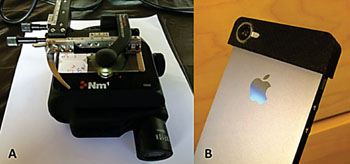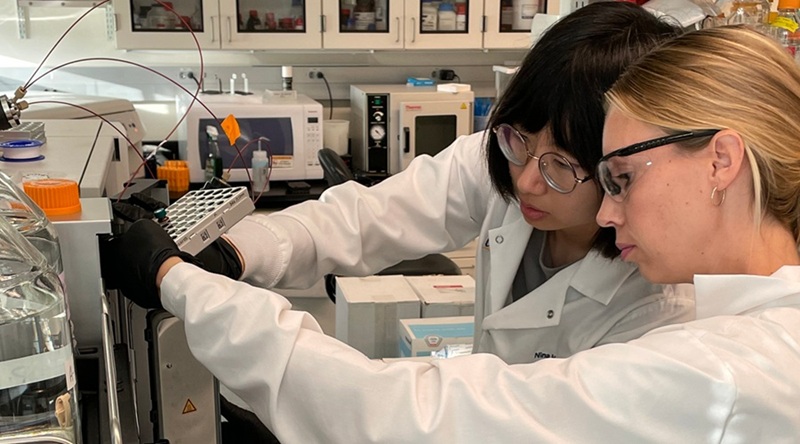Mobile Phone-Based Microscopes Diagnose Intestinal Parasites
|
By LabMedica International staff writers Posted on 13 Jul 2016 |

Image: Handheld- and mobile phone-based microscopes: A) The Newton Nm1-600 XY portable field microscope B) The reversed-lens CellScope attached to an iPhone 5s (Photo courtesy of University Health Network).
Handheld, mobile phone-based microscopes can be used in developing countries after minimal training of community laboratory technicians to diagnose intestinal parasites quickly and accurately.
Intestinal worms affect almost two billion people world-wide, predominantly in areas with poor sanitation and unsafe water and in children, these parasites may lead to malnutrition, stunted growth and development and can lead to chronic disability, with serious health and economic consequences.
An international team of scientists led by those at the University of Toronto (ON, Canada) trained local laboratory technicians to operate the two handheld microscopes. In total, the technicians examined stool and urine samples from 226 individuals for the detection of parasites. The accuracy of all slides was evaluated by all microscopes: the two handheld devices, as well as a conventional, “gold standard” microscope.
The two portable handheld microscopes:tested were a commercial Newton Nm1 microscope (Newton Microscopes, Bedford, UK) and a mobile phone-based CellScope (CellScope Inc, San Francisco, CA, USA) which is essentially a smartphone with a special custom-fitted lens attached over the camera and light source, developed by engineers, to detect intestinal parasites. Slides were first evaluated using an Olympus CX21 microscope (Volketswil, Switzerland) as the gold standard.
The scientists reported that the two handheld microscopes were very good at ruling in infections, and the Newton portable microscope was able to detect even very low-burden infections. The CellScope missed some low-burden infections, however newer iterations of this device are currently being tested to increase its sensitivity.
Isaac I. Bogoch, MD, the lead investigator said, “It was heart-warming to see how well and easily these portable, handheld field microscopes were adopted and used in a rural setting. This will help us map out the areas of greatest need. Novel diagnostic approaches for common parasitic infections could have a profound impact on care of patients, as well as on public health approaches to screening in resource-poor areas.” The study was published on June 27, 2016, in the journal PLOS Neglected Tropical Diseases.
Related Links:
University of Toronto
Newton Microscopes
CellScope
Olympus
Intestinal worms affect almost two billion people world-wide, predominantly in areas with poor sanitation and unsafe water and in children, these parasites may lead to malnutrition, stunted growth and development and can lead to chronic disability, with serious health and economic consequences.
An international team of scientists led by those at the University of Toronto (ON, Canada) trained local laboratory technicians to operate the two handheld microscopes. In total, the technicians examined stool and urine samples from 226 individuals for the detection of parasites. The accuracy of all slides was evaluated by all microscopes: the two handheld devices, as well as a conventional, “gold standard” microscope.
The two portable handheld microscopes:tested were a commercial Newton Nm1 microscope (Newton Microscopes, Bedford, UK) and a mobile phone-based CellScope (CellScope Inc, San Francisco, CA, USA) which is essentially a smartphone with a special custom-fitted lens attached over the camera and light source, developed by engineers, to detect intestinal parasites. Slides were first evaluated using an Olympus CX21 microscope (Volketswil, Switzerland) as the gold standard.
The scientists reported that the two handheld microscopes were very good at ruling in infections, and the Newton portable microscope was able to detect even very low-burden infections. The CellScope missed some low-burden infections, however newer iterations of this device are currently being tested to increase its sensitivity.
Isaac I. Bogoch, MD, the lead investigator said, “It was heart-warming to see how well and easily these portable, handheld field microscopes were adopted and used in a rural setting. This will help us map out the areas of greatest need. Novel diagnostic approaches for common parasitic infections could have a profound impact on care of patients, as well as on public health approaches to screening in resource-poor areas.” The study was published on June 27, 2016, in the journal PLOS Neglected Tropical Diseases.
Related Links:
University of Toronto
Newton Microscopes
CellScope
Olympus
Latest Technology News
- Machine Learning Models Diagnose ALS Earlier Through Blood Biomarkers
- Artificial Intelligence Model Could Accelerate Rare Disease Diagnosis
- AI Saliva Sensor Enables Early Detection of Head and Neck Cancer
- AI-Powered Biosensor Technology to Enable Breath Test for Lung Cancer Detection
- AI Model Achieves Breakthrough Accuracy in Ovarian Cancer Detection
- Portable Biosensor Diagnoses Psychiatric Disorders Using Saliva Samples
- Cell-Sorting Device Uses Electromagnetic Levitation to Precisely Direct Cell Movement

- Embedded GPU Platform Enables Rapid Blood Profiling for POC Diagnostics
- Viral Biosensor Test Simultaneously Detects Hepatitis and HIV
- Acoustofluidic Device to Transform Point-Of-Care sEV-Based Diagnostics
- AI Algorithm Assesses Progressive Decline in Kidney Function
Channels
Clinical Chemistry
view channel
Online Tool Detects Drug Exposure Directly from Patient Samples
Doctors often rely on patient interviews and medical records to determine what medications a person has taken, but this information is frequently incomplete. People may forget drugs they used, take over-the-counter... Read more
Chemical Imaging Probe Could Track and Treat Prostate Cancer
Prostate cancer remains a leading cause of illness and death among men, with many patients eventually developing resistance to standard hormone-blocking therapies. These drugs often lose effectiveness... Read moreMolecular Diagnostics
view channel
New 15-Minute Hepatitis C Test Paves Way for Same-Day Treatment
Chronic hepatitis C infection affects an estimated 50 million people worldwide and causes around 242,000 deaths each year, largely due to cirrhosis and liver cancer. Although the infection is curable with... Read more
Ovarian Cancer Assay Outperforms Traditional Tests in Early Disease Detection
Globally, ovarian cancer is one of the deadliest cancers affecting women. Traditionally, early diagnosis of ovarian cancer has been challenging. Many ovarian cancers are diagnosed only after they have... Read moreHematology
view channel
MRD Tests Could Predict Survival in Leukemia Patients
Acute myeloid leukemia is an aggressive blood cancer that disrupts normal blood cell production and often relapses even after intensive treatment. Clinicians currently lack early, reliable markers to predict... Read more
Platelet Activity Blood Test in Middle Age Could Identify Early Alzheimer’s Risk
Early detection of Alzheimer’s disease remains one of the biggest unmet needs in neurology, particularly because the biological changes underlying the disorder begin decades before memory symptoms appear.... Read more
Microvesicles Measurement Could Detect Vascular Injury in Sickle Cell Disease Patients
Assessing disease severity in sickle cell disease (SCD) remains challenging, especially when trying to predict hemolysis, vascular injury, and risk of complications such as vaso-occlusive crises.... Read more
ADLM’s New Coagulation Testing Guidance to Improve Care for Patients on Blood Thinners
Direct oral anticoagulants (DOACs) are one of the most common types of blood thinners. Patients take them to prevent a host of complications that could arise from blood clotting, including stroke, deep... Read moreImmunology
view channel
Routine Blood Test Can Predict Who Benefits Most from CAR T-Cell Therapy
CAR T-cell therapy has transformed treatment for patients with relapsed or treatment-resistant non-Hodgkin lymphoma, but many patients eventually relapse despite an initial response. Clinicians currently... Read more
New Test Distinguishes Vaccine-Induced False Positives from Active HIV Infection
Since HIV was identified in 1983, more than 91 million people have contracted the virus, and over 44 million have died from related causes. Today, nearly 40 million individuals worldwide live with HIV-1,... Read more
Gene Signature Test Predicts Response to Key Breast Cancer Treatment
DK4/6 inhibitors paired with hormone therapy have become a cornerstone treatment for advanced HR+/HER2– breast cancer, slowing tumor growth by blocking key proteins that drive cell division.... Read more
Chip Captures Cancer Cells from Blood to Help Select Right Breast Cancer Treatment
Ductal carcinoma in situ (DCIS) accounts for about a quarter of all breast cancer cases and generally carries a good prognosis. This non-invasive form of the disease may or may not become life-threatening.... Read morePathology
view channel
Rapid Low-Cost Tests Can Prevent Child Deaths from Contaminated Medicinal Syrups
Medicinal syrups contaminated with toxic chemicals have caused the deaths of hundreds of children worldwide, exposing a critical gap in how these products are tested before reaching patients.... Read more
Tumor Signals in Saliva and Blood Enable Non-Invasive Monitoring of Head and Neck Cancer
Head and neck cancers are among the most aggressive malignancies worldwide, with nearly 900,000 new cases diagnosed each year. Monitoring these cancers for recurrence or relapse typically relies on tissue... Read more
Common Health Issues Can Influence New Blood Tests for Alzheimer’s Disease
Blood-based tests for Alzheimer’s disease are transforming diagnosis by offering a simpler alternative to spinal taps and brain imaging. However, many people evaluated at memory clinics also live with... Read more
Blood Test Formula Identifies Chronic Liver Disease Patients with Higher Cancer Risk
Chronic liver disease affects millions worldwide and can progress silently to hepatocellular carcinoma (HCC), one of the deadliest cancers globally. While surveillance guidelines exist for patients with... Read moreTechnology
view channel
Machine Learning Models Diagnose ALS Earlier Through Blood Biomarkers
Amyotrophic lateral sclerosis (ALS) is a rapidly progressive neurodegenerative disease that is notoriously difficult to diagnose in its early stages. Early symptoms often overlap with other neurological... Read more
Artificial Intelligence Model Could Accelerate Rare Disease Diagnosis
Identifying which genetic variants actually cause disease remains one of the biggest challenges in genomic medicine. Each person carries tens of thousands of DNA changes, yet only a few meaningfully alter... Read moreIndustry
view channel
Abbott Acquires Cancer-Screening Company Exact Sciences
Abbott (Abbott Park, IL, USA) has entered into a definitive agreement to acquire Exact Sciences (Madison, WI, USA), enabling it to enter and lead in fast-growing cancer diagnostics segments.... Read more



















